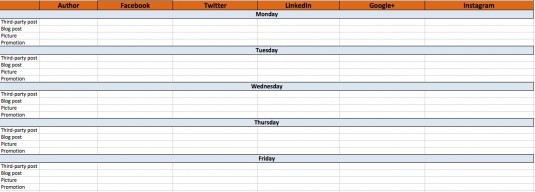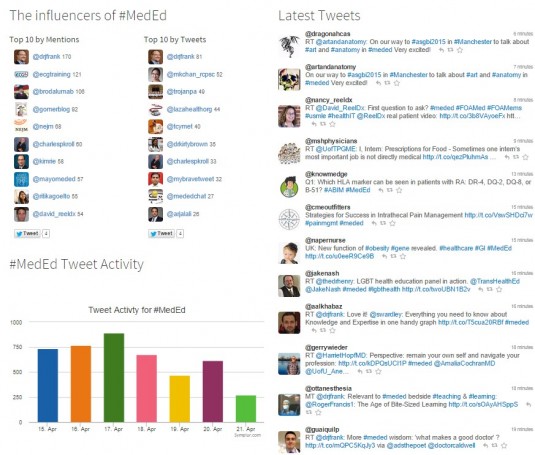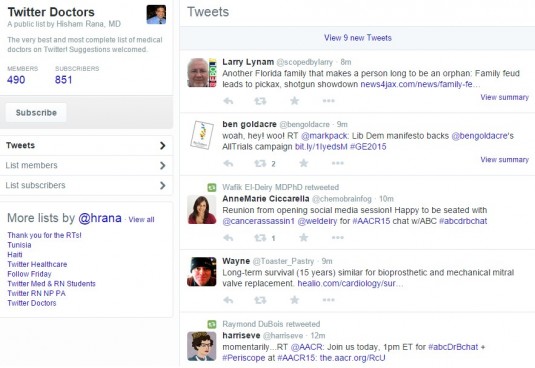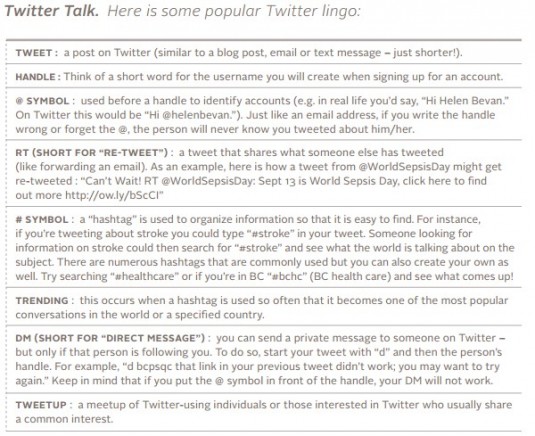Four Practical Ways Healthcare Organizations Can Use Twitter
 Twitter could be a healthcare organization’s best tool for campaigning. Doctors and other healthcare professionals can spread informative articles, new findings and anything else with just the click of a button. By connecting with so many people in one convenient place, information can reach anyone with access to the blue bird’s “nest.”
Twitter could be a healthcare organization’s best tool for campaigning. Doctors and other healthcare professionals can spread informative articles, new findings and anything else with just the click of a button. By connecting with so many people in one convenient place, information can reach anyone with access to the blue bird’s “nest.”
Here are 4 practical ways healthcare organizations can use Twitter effectively:
- Create original hashtags and an editorial calendar
- Use Twitter Chats
- Communicate with other experts
- Create Lists
Healthcare organizations and doctors have slowly been jumping on the social media bandwagon. Just in case you are new to Twitter, the next section will give you the quick tips you need to understand Twitter lingo.
 Learn the Lingo
Learn the Lingo
The University of Durham created a short informative introduction guide for healthcare professionals learning to use Twitter.
Take a look at the chart and get familiar with the terms found all across Twitter. Healthcare professionals will ease into the platform easier once the basics are learned.
Trending is a term that is specifically useful to healthcare organizations. Healthcare marketers will benefit from learning what is trending on Twitter to get messages out quickly to as many people as possible. How do you get something trending? Hashtags!
Create and Promote Unique Hashtags
Hashtags (#) are the easiest way to connect with hundreds of people talking about the same thing. Just any hashtag won’t do the organization any good though, you must make sure to create something unique that better develops the identity and brand the organization is trying to create.
If you are a private practice, create a hashtag that highlights what your practice is all about. If your practice is physical therapy, try something like #stretchingiskey to engage your followers. If your followers share your hashtag, your small private practice may get some more traffic by getting your practice’s name out on Twitter.
In addition to using hashtags to get your message and voice out to the public, creating a social media editorial calendar is an effective way to keep tweets organized and fluid. Hootsuite, a helpful social media tool that healthcare organizations can and should use, created a social media campaign calendar template.

Planning your tweets ahead of time ensures that campaigns keep up with trends and post consistently each day. This also saves time when planning on what to tweet about and when to post. I highly recommend healthcare professionals and organizations take a look at Hootsuite and plan calendars sooner rather than later. If you’re not sure if Hootsuite is right for your organization, you can request a free demo! There is no harm in trying to get organized.
Bird is the Word
Tweet Chats are a great way to connect healthcare professionals to their patients and followers. Twitter’s Tweet Chat feature allows doctors to host discussions online, giving patients the opportunity to ask questions and learn more about the topic being addressed.
 A great example of a Tweet Chat is #MedEd, which conveniently has its own twitter handle. The Medical Education community gets together weekly for one hour on Thursday nights. The importance of hosting this weekly conversation is to address topics related to medical education and to spread the information through social media.
A great example of a Tweet Chat is #MedEd, which conveniently has its own twitter handle. The Medical Education community gets together weekly for one hour on Thursday nights. The importance of hosting this weekly conversation is to address topics related to medical education and to spread the information through social media.
A nifty website called Symplur tracks Twitter chats like #MedEd and compiles analytics for the organization or individual holding the chat. The image to the right shows the activity of the Twitter Chat, who participated in the chat and the influencers of #MedEd. One of Symplur’s features shows comparable hashtags that are getting more traffic than the current one. These comparisons help organizations that may need to tweak or change their hashtags to reach as many people as possible.
 Communication is Key for all Relationships
Communication is Key for all Relationships
In addition to Twitter Chats, mentioning (@) other healthcare professionals on a daily basis is a great practice. It will not only secure your reputation, but will boost others’ as well. Referral MD outlines a section on their blog post for communication between experts. Referral MD suggests interacting with other healthcare experts’ tweets by asking questions and giving constructive criticism. This will build a relationship between your healthcare expertise online and in the office.
Referral MD also suggests asking other professionals to have coffee or meet face-to-face. Meeting in person will help establish a long-term relationship that may not have occurred online. It is highly likely that the experts you come into contact with don’t live near you, so try inviting them to a conference to share expertise or to meet in person.
Listing is Not Just for Groceries
Twitter’s new powerful list feature is a great way to keep tweets organized and in one place. Lists allow you to sort who you follow to organize the influx of tweets you may be getting on a daily basis.
A list created by Hisham Rana, MD has 490 members and most, if not all, are medical professionals. On top of curating  all top doctors on Twitter, Twitter lists allow subscribers to the discussions between these 490 members. This makes listing the easiest way to get connected to a specific expert in any field of medicine within minutes of logging on.
all top doctors on Twitter, Twitter lists allow subscribers to the discussions between these 490 members. This makes listing the easiest way to get connected to a specific expert in any field of medicine within minutes of logging on.
The perks of lists include:
- Organization of Twitter Members
- Tweets are easy to follow within the group
- Other lists created by the user are located on the same page
Along with these perks, Twitter lists can serve as a hot spot for your healthcare organization or for the professionals working for you.
Hopefully you now have the knowledge and confidence to build a successful Twitter campaign for your healthcare organization.
If you’re interested in more content about healthcare and marketing, read here.
Thomas Kilbride—Content Creator

 Learn the Lingo
Learn the Lingo Communication is Key for all Relationships
Communication is Key for all Relationships

